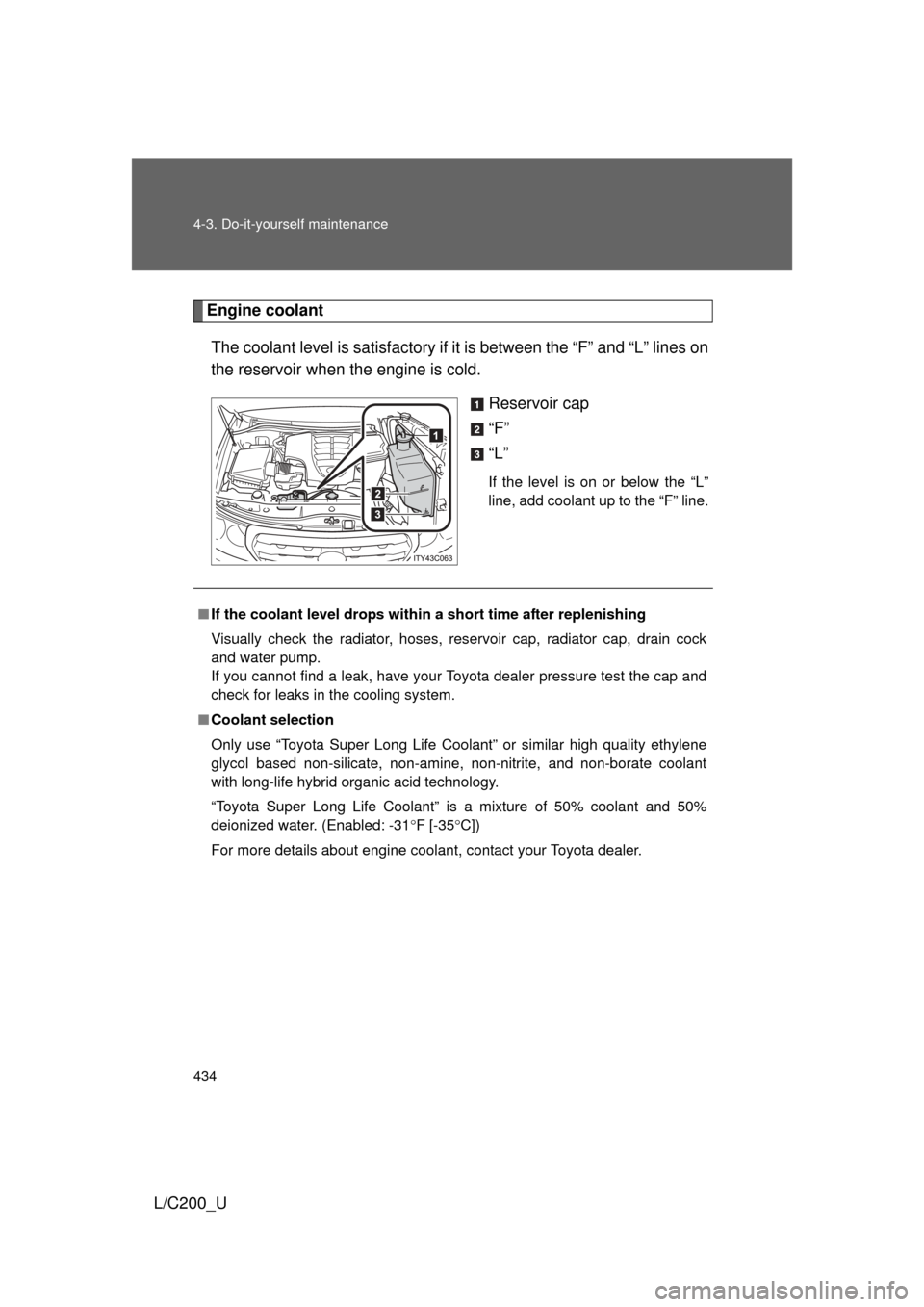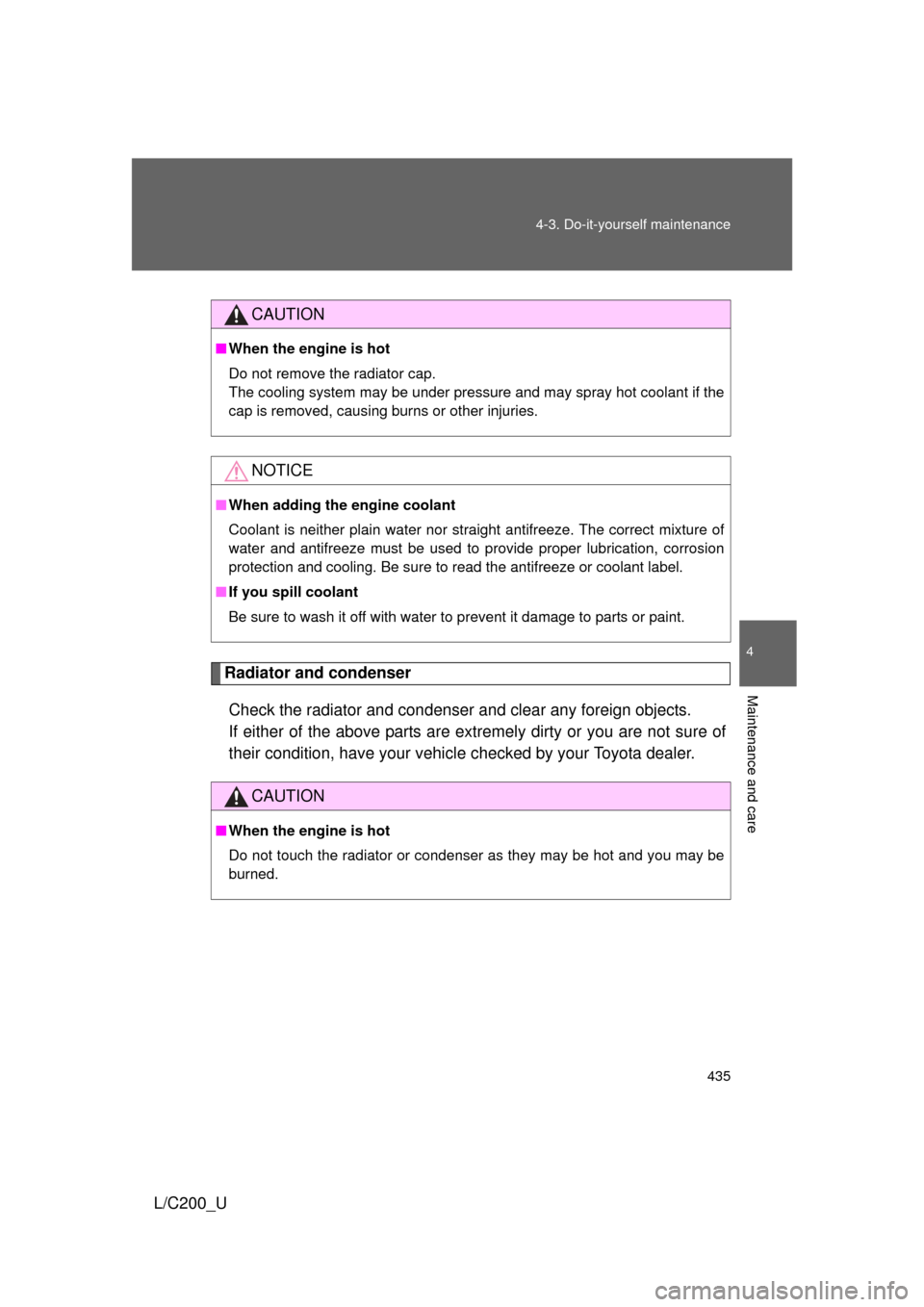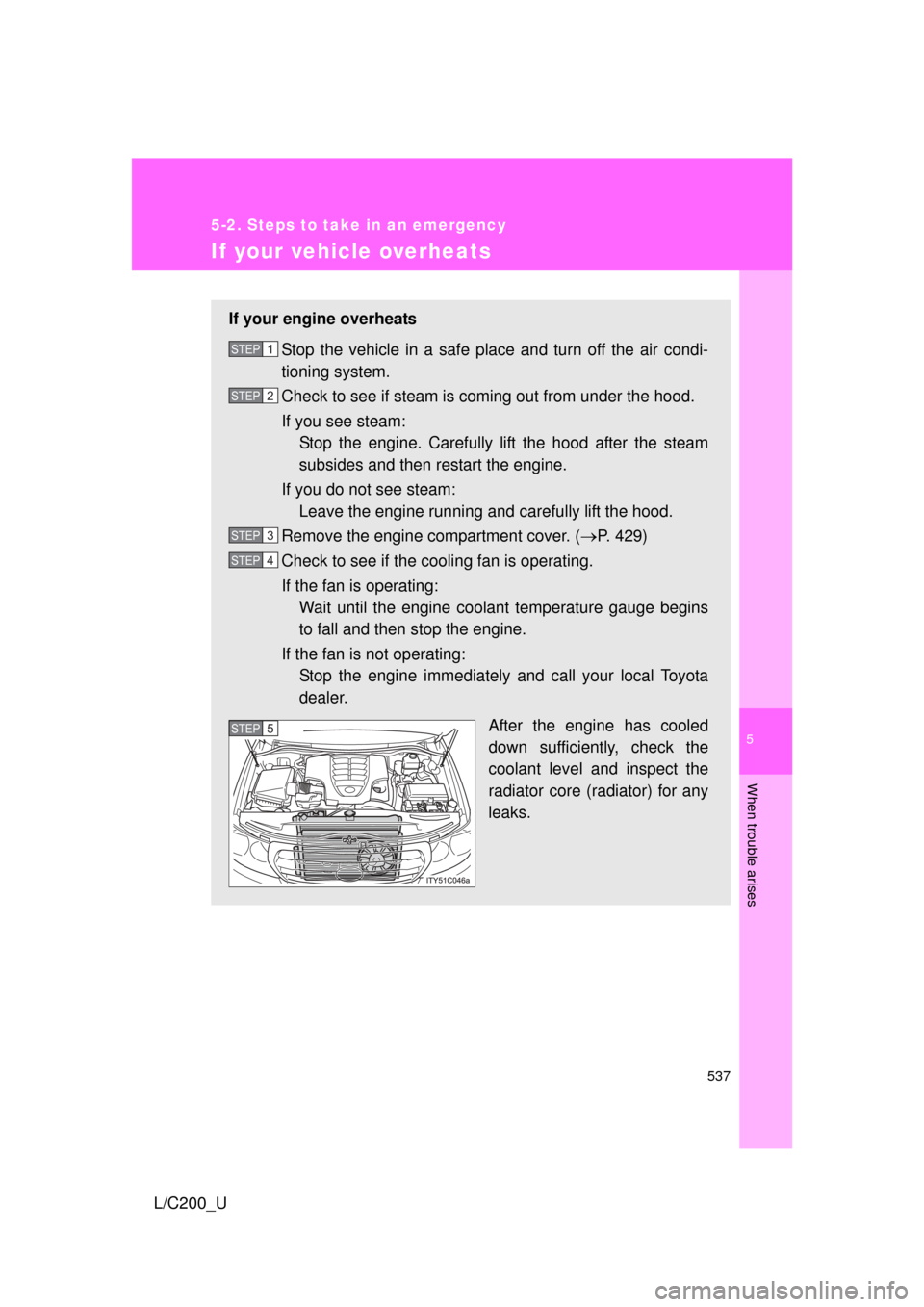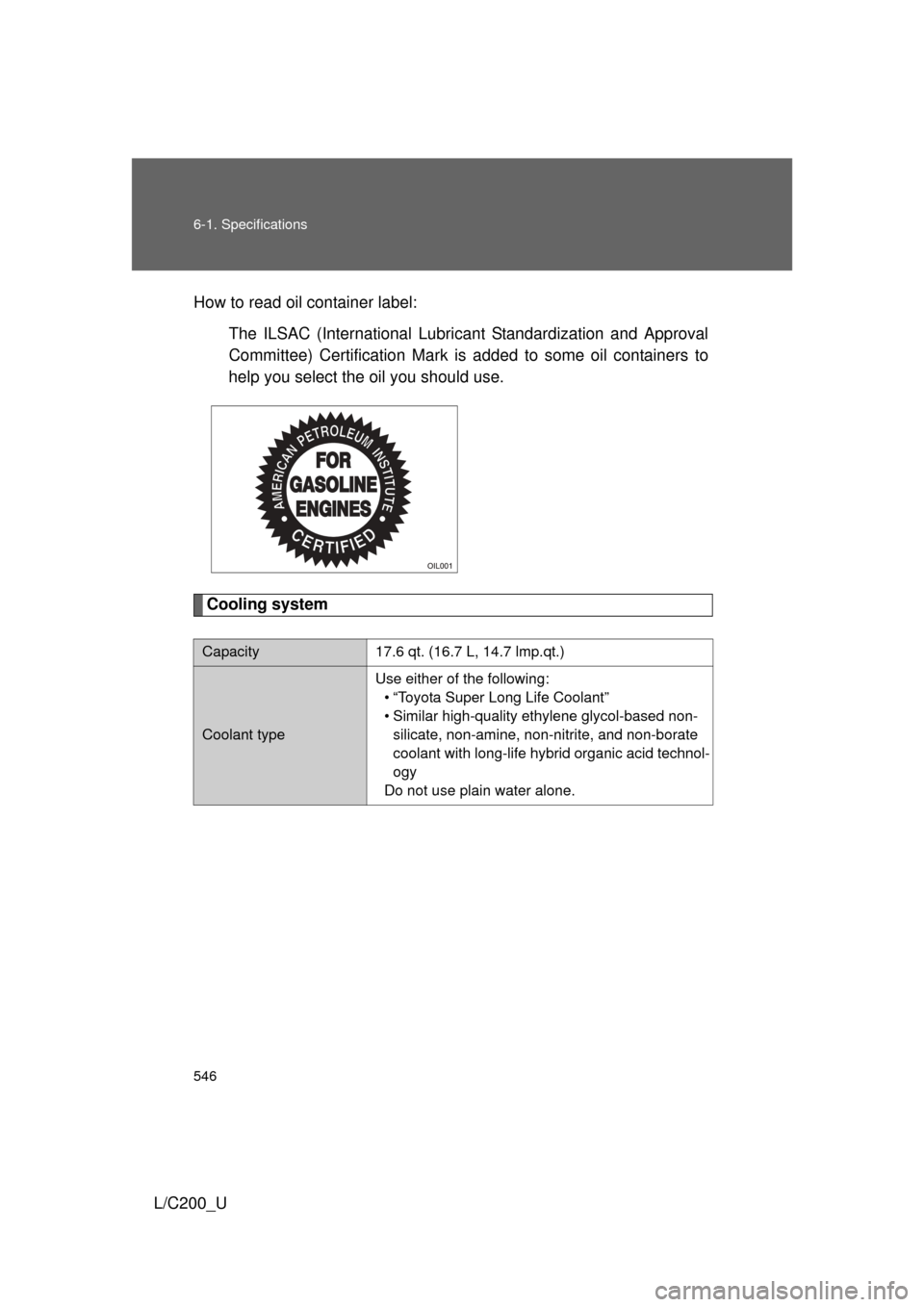2010 TOYOTA LAND CRUISER cooling
[x] Cancel search: coolingPage 426 of 592

426 4-3. Do-it-yourself maintenance
L/C200_U
CAUTION
The engine compartment contains many mechanisms and fluids that may
move suddenly, become hot, or become electrically energized. To avoid death
or serious injury.
■When working on the engine compartment
● Keep hands, clothing, and tools away from the moving fan and engine
drive belt.
● Be careful not to touch the engine, inverter, radiator, exhaust manifold, etc.
right after driving as they may be hot. Oil and other fluids may also be hot.
● Do not leave anything that may burn easily, such as paper or rags, in the
engine compartment.
● Do not smoke, cause sparks or expose an open flame to fuel or the bat-
tery. Fuel and battery fumes are flammable.
● Be extremely cautious when working on the battery. It contains poisonous
and corrosive sulfuric acid.
■ When working near the electric cooling fan or radiator grille
Be sure the “ENGINE START STOP” switch is OFF.
With the “ENGINE START STOP” switch in IGNITION ON mode, the electric
cooling fan may automatically start to run if the air conditioning is on and/or if
the coolant temperature is high. ( P. 435)
■ When working on or under the vehicle
● Do not get under the vehicle with just the jack supporting it.
Always use automotive jack stands or other solid supports.
● Use eye protection to prevent flying or falling material, fluid spray, etc. from
getting in your eyes.
NOTICE
■If you remove the air cleaner filter
Driving with the air cleaner filter removed may cause excessive engine wear
due to dirt in the air. Also a backfire could cause a fire in the engine compart-
ment.
Page 428 of 592

428
4-3. Do-it-yourself maintenance
L/C200_U
Engine compar tment
Power steering fluid reser-
voir (P. 438)
Engine oil level dipstick ( P. 430)
Engine coolant reservoir ( P. 434)
Cooling fans
Engine oil filler cap ( P. 431)Brake fluid reservoir
( P. 436)
Fuse box ( P. 464)
Washer fluid tank ( P. 442)
Battery ( P. 439)
Condenser ( P. 435)
Radiator ( P. 435)
Page 434 of 592

434 4-3. Do-it-yourself maintenance
L/C200_U
Engine coolantThe coolant level is sati sfactory if it is between the “F” and “L” lines on
the reservoir when the engine is cold.
Reservoir cap
“F”
“L”
If the level is on or below the “L”
line, add coolant up to the “F” line.
■If the coolant level drops within a short time after replenishing
Visually check the radiator, hoses, reservoir cap, radiator cap, drain cock
and water pump.
If you cannot find a leak, have your Toyota dealer pressure test the cap and
check for leaks in the cooling system.
■ Coolant selection
Only use “Toyota Super Long Life Coolant” or similar high quality ethylene
glycol based non-silicate, non-amine, non-nitrite, and non-borate coolant
with long-life hybrid organic acid technology.
“Toyota Super Long Life Coolant” is a mixture of 50% coolant and 50%
deionized water. (Enabled: -31 F [-35 C])
For more details about engine coolant, contact your Toyota dealer.
Page 435 of 592

435
4-3. Do-it-yourself maintenance
4
Maintenance and care
L/C200_U
Radiator and condenser
Check the radiator and condenser and clear any foreign objects.
If either of the above parts are extremely dirty or you are not sure of
their condition, have your vehicl e checked by your Toyota dealer.
CAUTION
■When the engine is hot
Do not remove the radiator cap.
The cooling system may be under pressure and may spray hot coolant if the
cap is removed, causing burns or other injuries.
NOTICE
■When adding the engine coolant
Coolant is neither plain water nor stra ight antifreeze. The correct mixture of
water and antifreeze must be used to provide proper lubrication, corrosion
protection and cooling. Be sure to read the antifreeze or coolant label.
■ If you spill coolant
Be sure to wash it off with water to prevent it damage to parts or paint.
CAUTION
■When the engine is hot
Do not touch the radiator or condenser as they may be hot and you may be
burned.
Page 536 of 592

536 5-2. Steps to take in an emergency
L/C200_U
CAUTION
■Avoiding battery fires or explosions
Observe the following precautions to prevent accidentally igniting the flam-
mable gas that may be emitted from the battery.
● Make sure the jumper cable is connected to the correct terminal and that it
is not unintentionally in contact with any part other than the intended termi-
nal.
● Do not allow the jumper cables to come into contact with the “+” and “-” ter-
minals.
● Do not allow open flame or use matc hes, cigarette lighters or smoke near
the battery.
■ Battery precautions
The battery contains poisonous and corrosive acidic electrolyte, while
related parts contain lead and lead compounds. Observe the following pre-
cautions when handling the battery:
● When working with the battery, always wear safety glasses and take care
not to allow any battery fluids (acid) to come into contact with skin, clothing
or the vehicle body.
● Do not lean over the battery.
● If the battery fluid comes into contact with the skin or eyes, immediately
wash the affected area with water and seek medical attention.
Place a wet sponge or cloth over the affected area until medical attention
can be received.
● Always wash your hands after handling the battery support, terminals, and
other battery-related parts.
● Do not allow children near the battery.
NOTICE
■When handling jumper cables
Be careful that the jumper cables do not become tangled in the cooling fan
or any of the belts when connecting or disconnecting them.
Page 537 of 592

5
When trouble arises
537
5-2. Steps to take in an emergency
L/C200_U
If your vehicle overheats
If your engine overheatsStop the vehicle in a safe place and turn off the air condi-
tioning system.
Check to see if steam is coming out from under the hood.
If you see steam: Stop the engine. Carefully lift the hood after the steam
subsides and then restart the engine.
If you do not see steam: Leave the engine running and carefully lift the hood.
Remove the engine compartment cover. (
P. 429)
Check to see if the cooling fan is operating.
If the fan is operating: Wait until the engine coolant temperature gauge begins
to fall and then stop the engine.
If the fan is not operating: Stop the engine immediately and call your local Toyota
dealer.
After the engine has cooled
down sufficiently, check the
coolant level and inspect the
radiator core (radiator) for any
leaks.
STEP1
STEP2
STEP3
STEP4
STEP5
Page 546 of 592

546 6-1. Specifications
L/C200_UHow to read oil container label:
The ILSAC (International Lubricant Standardization and Approval
Committee) Certification Mark is added to some oil containers to
help you select the oil you should use.
Cooling system
Capacity17.6 qt. (16.7 L, 14.7 lmp.qt.)
Coolant type
Use either of the following:
• “Toyota Super Long Life Coolant”
• Similar high-quality ethylene glycol-based non-silicate, non-amine, non-nitrite, and non-borate
coolant with long-life hybrid organic acid technol-
ogy
Do not use plain water alone.
Page 583 of 592

583
Alphabetical index
L/C200_U
Brake assist ............................. 206
Break-in tips ............................ 143
Brightness control
Instrument light control ......... 165
Care Exterior ................................. 412
Interior .................................. 415
Seat belts ............................. 416
Card holder .............................. 379
Cargo capacity ........................ 218
Cargo net hooks ...................... 395
CD player/changer .................. 274
Center differential lock/unlock switch ................ 197
Chains ...................................... 228
Child-protectors ........................ 43
Child restraint system Booster seats, definition ....... 124
Booster seats, installation .... 128
Convertible seats, definition............................. 124
Convertible seats, installation .......................... 128
Front passenger occupant classification system .......... 118
Infant seats, definition .......... 124
Infant seats, installation ........ 128
Installing CRS with LATCH system ..... .............. 129
Installing CRS with seat belts............................ 131
Installing CRS with top
straps ................................. 136
Child safety Airbag precautions ............... 111
Battery precautions ...... 441, 463
Child-protectors ...................... 43
Child restraint system ........... 124
How your child should wear
the seat belt ......................... 76 Installing child restraints ........128
Moon roof precautions ............91
Power window lock switch.......86
Power window precautions .....88
Removed key battery
precautions .........................461
Seat belt extender precautions ...........................79
Seat belt precautions ..............77
Seat heater precautions ........392
Cigarette lighter .......................388
Cleaning Exterior ..................................412
Interior ...................................415
Seat belts ..............................416
Clock .........................................384
Condenser ................................435
Console box .............................374
Cool box....................................380
Cooling system Engine overheating ...............537
Cruise control...........................184
Cup holder ................................376
Crawl Control ...........................202
Curtain shield airbags .............103
Customizable features.............567
Daytime running light
system ....................................175
Defogger
Rear window .........................260
Dimension.................................542
Dinghy towing ..........................243
Display Crawl Control display ............202
Intuitive parking assist display.................................188
Trip information .....................171
Shift position and shift range...................................158
Warning messages ...............511
C
D